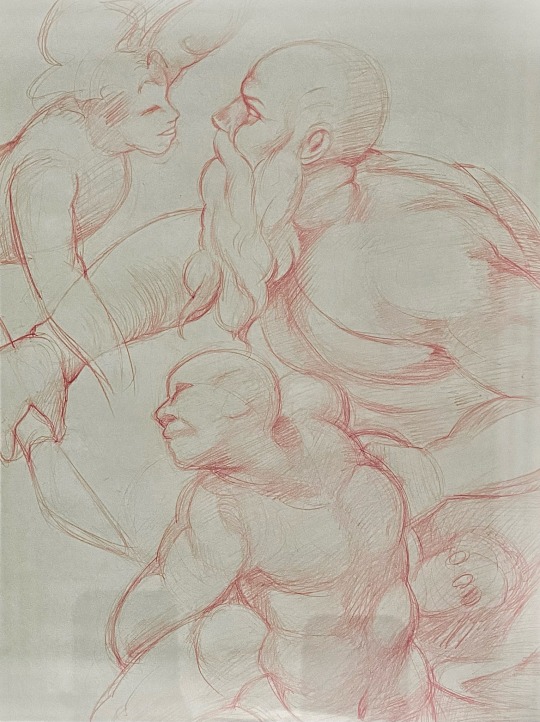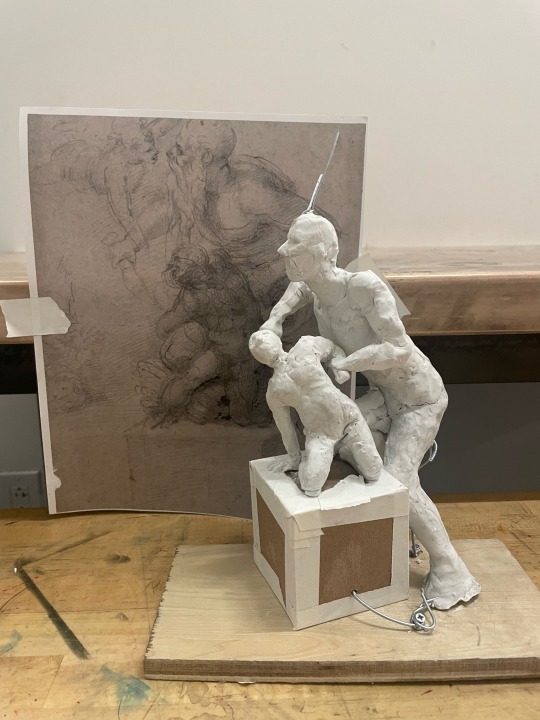#Biblical Stories
Explore tagged Tumblr posts
Text

Alexandre Cabanel, Samson and Delilah (𝟣𝟪𝟩𝟪)
#alexandre cabanel#oil painting#oil on canvas#19th century#romantic period#painter#art#biblical stories#bible#painting#romanticism#myths and legends#academia#traditional art#classical art#romance#dark academia#betrayal#classic academia#romantic academia#museum#artist#dark romanticism#artists on tumblr#love#lovers#myths#painters on tumblr#artwork
115 notes
·
View notes
Text

Angelique Benicio, Salomé, 2024, oil on wood, 8 × 10 inches.
43 notes
·
View notes
Text
Carol Ochs, in The Myth Behind the Sex of God, discusses the story of Abraham, Isaac and Sarah and finds that in order to prove that Abraham is not rooted in the older tradition, God demands that he renounce the most fundamental tenet of the matriarchal religion and kill his own child. Abraham's choice is between the matriarchal principle of protecting his child and the patriarchal principle of following an abstract ethic, obedience to God. Abraham passes the test and is pronounced fit to be the father of a new, patriarchal religion.
Naomi Goldenberg maintains that giving voice to biblical women cannot save Judaism or the Old Testament for, as she says, "The nature of the religion lies in interplay between a father-God and his Sons. In such a religion, women will always be on the periphery." Some women scholars advocate the complete abandonment of Judaism and Christianity. Others are working to reform these traditions by removing various sexist practices. Goldenberg sees the reformers as engaged in a hopeless effort. She feels that it is futile to defend patriarchal creeds.
-Shirley Ann Ranck, Cakes for the Queen of Heaven
#Shirley Ann Ranck#xtianity#anti christian#patriarchal religion#biblical stories#male violence#female oppression#tbr list
19 notes
·
View notes
Text




Elizabeth Hurley as Delilah in Samson and Delilah, 1996
#elizabeth hurley#samson and delilah#delilah#biblical stories#bible story#movies#movie gifs#gifset#my gifs#gif edit#gifs#actress#aesthetic
38 notes
·
View notes
Text

Agostino Tassi, The Miraculous Draught of Fishes, ca. 1580-1664
#biblical#italian#italian art#agostino tassi#art#painting#oil on canvas#the miraculous draught of fishes#biblical stories#1500s#1600s#16th century art#17th century art
11 notes
·
View notes
Text


Speedpaint attempt #5! Hebrew soldier.
Ok I'm getting the hang of this now...
I used Pallid Bone, Beowulf Blue, and mix of metal, satchel brown, and zealot yellow for the bronze. Skin and hair was done traditionally.
I hope you like it!
#customkits#hobby#fun#painting miniatures#table top games#dnd#red copper miniatures#hebrew#bible#biblical stories#old testament#ancient history#near east#qadesh#army painter
6 notes
·
View notes
Text
I've done this once or twice now, so I'm willing to give it another shot—
I'm looking to start up a small roleplay group. Ideally, between five and nine individuals. Some need to know things mechanic wise:
The roleplay group will be run like a tabletop roleplay game [ttrpg].
It will be played very similar to Dungeon and Dragons [DnD] or Pathfinder. For those familiar with the system. When I say its similar, it uses the same dice sets, stats, and usage of rolls. But it has its entire own handbook for skills, feats, classes, equipment and the likes. But you don't need any experience if you don't know the other ttrpg systems, as it has its own handbook for you to access.
It will be in text format however, like a roleplay. People will tag each other after their replies. And you'll have access to an entire server with different channel and sections for different places to explore in character.
Every individual/player will have one character (unless they would like to have a second or third, or wish to play what could be classified as an npc).
Now, if it's caught your attention this far. I'll let you know the premise of the game/roleplay:
The player/individual's characters receive a scholarship from an intentional school. It is a full ride for housing, tuition, supplies, and anything else they might need. But there is trickery afoot they have to unravel and navigate.
Things you won't necessarily know in character however: every player/character is a demigod. They have divine blood. And the reason they are brought to the school is for their divine parent to try to reconnect with them.
Other themes that there will be
If you like Percy Jackson, and wanted a ttrpg system for it. Or if you just like mythology in general.
If you like the dark academia aesthetic.
If you like the found family trope.
If you like time traveling, or second experiences.
Now, if you've made it this far, I only have a very few requests I would ask of you:
I know a lot might be interested, but again I will restate: I'm looking for between 6-9 people.
Please be 18+, there will be mature topics discussed.
Be LGBTQ+ friendly
And if you're interested, send me a message and we'll chat. I'll get you the link to the group server on discord, and we'll start making your characters.
Thank you for reading this far. I hope this reaches the right crowd!
#ttrpg#Ttrpg group#ttrpg community#ttrpg campaign#Discord server#Roleplay group#group roleplay#Roleplay server#Mythology#percy jackson#Mythos kids#Greek mythology#Norse mythology#Hindu mythology#Egyptian mythology#Mesoamerican mythology#Sumerian mythology#Celtic mythology#All the mythology#Biblical stories#Biblical#Time travel#Time traveling#Found family#discord chat#Discord community#Roleplay community#Dark academia
17 notes
·
View notes
Text



Weirdly biblical piece for me- it was an assignment to draw piece from a different perspective in order to change the story. The original piece is by Michelangelo, ‘Sacrifice of Issac’
5 notes
·
View notes
Text

"Don't you kids know anything? The Serpent of Rehoboam? The Well of Zohassadar? The Bridal Feast of Beth Chedruharazzeb?"
0 notes
Text
The stories of Lot in Sodom and of the origin of the Benjaminite war deal obliquely with the position of women. As told in Genesis 19, two angels in the form of two strangers come as visitors to Lot's house in Sodom. Lot makes a feast for them and invites them to stay overnight. The wicked men of Sodom surround the house and demand that he surrender the men to them, "Bring them out unto us that we may know them." Trying to calm them down, Lot steps outside the door of his house and addresses the Sodomites as follows:
I pray you, my brethren, do not so wickedly. Behold now, I have two daughters that have not known man; let me, I pray you, bring them out unto you, and do ye to them as is good in your eyes; only to these men do nothing; forasmuch as they are come under the shadow of my roof [Gen. 19:7,8].
The mob storms into the house, but the angels strike the men of the mob with blindness, then they warn Lot of the imminent destruction of the city of Sodom and tell him that he and his family would be saved, "the Lord being merciful to him." The language here indicates that Lot is not being saved for his virtue but because of God's mercy and because of Abraham. ('God remembered Abraham and sent Lot out of the midst of the overthrow, when he overthrew the cities in which Lot dwelt" (Gen. 19:29).
The passage has been embarrassing to later commentators. Martin Luther praised Lot for upholding the law of hospitality, and otherwise apologized for him: "I will defend Lot and think he made his offer without sin. For knowing that the mob was not interested in them, he only tried to appease it and did not think he was exposing his daughters to any danger." John Calvin, on the other hand, thought that "Lot's great virtue was sprinkled with some imperfection. He does not hesitate to prostitute his daughters ... Lot, indeed is urged by extreme necessity; yet ... he is not free from blame."
Later commentators have essentially followed these two lines of interpretation. Sarna comments that Lot's "willingness to allow his daughters to be violated" is "utterly incomprehensible" to the modern reader, "even if allowance be made for the fact that the story reflects an age and a society in which daughters were the property of their fathers." I find it remarkable that E. A. Speiser, who annotates and comments on Genesis line by line, has no comment to offer regarding Lot's action. He criticizes Lot for "lacking spontaneity" and appearing "servile" in his hospitality and describes the "latent weakness in Lot's character" in his being "undecided, flustered, ineffectual." The only hint of a comment on the incident with the daughters is the sentence: "True to the unwritten code, Lot will stop at nothing in his effort to protect his guests." Speiser follows Calvin's interpretation and, using a strictly textual analysis, Calvin seems quite justified in regarding Lot's offer of his daughter to the mob as merely "an imperfection," since Yahweh, to whom the crimes of Sodom are so abhorrent that he destroys the city and all its inhabitants, nevertheless saves Lot. If we analyze this Biblical story, we notice that Lot's right to dispose of his daughters, even so as to offer them to be raped, is taken for granted. It does not need to be explained; hence we can assume it reflected a historic social condition.
-Gerda Lerner, The Creation of Patriarchy
12 notes
·
View notes
Text



Elizabeth Hurley as Delilah in Samson and Delilah, 1996
#elizabeth hurley#samson and delilah#Delilah#bible story#biblical stories#gifset#movie gifs#my gifs#gifs#aesthetic#actress
27 notes
·
View notes
Text
The Presentation of Mary in the Temple: A Moment of Grace and Devotion
The Presentation of the Blessed Virgin Mary in the Temple is a beautiful and significant event in the life of the Church, celebrated on November 21st. This feast commemorates the moment when Saint Anne and Saint Joachim, the parents of Mary, brought her to the Temple in Jerusalem to consecrate her to the Lord. This act of dedication is a profound testament to their faith and devotion. The…
#Biblical Stories#Blessed Virgin Mary#Catholic Faith#Catholic Feast Days#Christian Inspiration#Divine Dedication#Faith and Devotion#Holiness and Sanctity#Mary’s Early Life#Presentation of Mary#Religious Traditions#Saint Anne and Saint Joachim#Spiritual Growth#Temple Presentation
0 notes
Text
#poem#poetry book#first book!#yippee#spiritual poetry#religious poetry#biblical figures#biblical stories#biblical studies#poems by me#check it ouuuut
1 note
·
View note
Text
Does it scare you to think about what Satan is trying to do to your kids?
What are you doing to make sure he doesn’t? Are you teaching your children about God?
Are you setting an example for them showing them what faithfulness looks like? Do you take them to church and Bible class?
Do you talk to them about the lies and immorality that the devil has made normal?
Do you keep them from playing video games and watching shows that slip in things that will take them off course? Do you pray for them and over them?
Don’t think for one second that you can let up or slack off. Evil doesn’t.

#Scripture#Holy Book#Christian Faith#Religious Text#Old Testament#New Testament#Gospel#Jesus Christ#Divine Revelation#Word of God#Biblical Stories#Salvation#Faith and Belief#Ten Commandments#Christian Doctrine#Prophets#Miracles#Redemption#Christian Ethics#Biblical Interpretation#today on tumblr
1 note
·
View note
Text
C.S. Lewis: oh and yeah, the stars are actually people who are functionally immortal (unless bitten by a witch who's shapeshifted into a snake) and come down to earth for rest periods wherein they look like normal humans and eat fire-berries until they can go be stars again, but they can be banished too and become magicians—
me: hold on
C.S. Lewis: keep up, there are also sea people (not mermaids) who have entire civilisations underwater, with dark purple hair and ivory skin, and they ride giant seahorses, and are very aggressive—
me: wait a second
C.S. Lewis: aren't you listening, because there is also a world underneath Narnia with many different sections, including one where Father Time sleeps until the end of the world, and a world underneath that called Bism where gems live and can be juiced like fruit—
me: just hang on a minute
C.S. Lewis: so you don't want to hear about how a centaur feeds both stomachs?
#narnia#cs lewis#me vs Lewis' approach to worldbuilding#aka dropping the wildest concepts into a whimsical story/ biblical allegory and then just. leaving them.#no further explanation required#ramblings & musings#queue know that it's time to emerge#also I'm listening to HaHB and majorly sideeyeing certain comments on the Calormens
610 notes
·
View notes
Text
wait btw this is just another thing nat will feel guilt for. she’s the one that handed hannah the knife, she’s gonna blame herself as the reason they go through another winter
230 notes
·
View notes